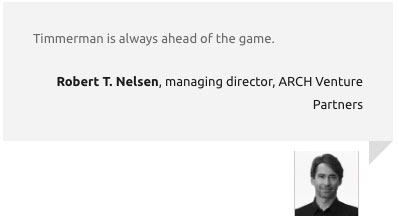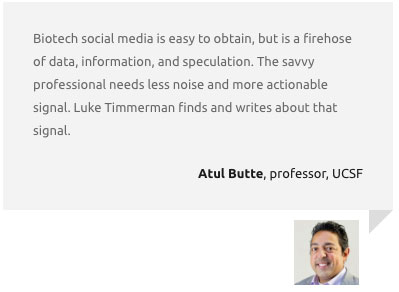The Cancer Moonshot Relaunched

Julie Grant, general partner, Canaan Partners
Last week, I had the honor of attending the Biden Administration’s relaunch of the Cancer Moonshot at the White House.
The Cancer Moonshot dates back to 2016, when then-Vice President Biden, mourning the death of his son Beau, spearheaded this bold initiative to accelerate the rate of progress against cancer on a national scale.
The initiative resulted in the 21st Century Cures Act, which included $1.8 billion for efforts including expanded NIH funding, new federal institutions within the FDA, new clinical trial networks, and much more.
When Obama and Biden left office, Joe and Jill Biden formed the Biden Cancer Initiative, a nonprofit organization that continued the work. I was invited to serve as a board member. It was one of the most meaningful experiences in my career and continues to motivate me when forming new oncology companies at Canaan Partners.

Julie Grant with President Biden at the Cancer Moonshot relaunch. Feb. 2, 2022.
Now in the White House, President Biden, Vice President Harris, and the First Lady are in position to bring back the early momentum and set new goals. Many of the headlines from this week’s ceremony focused on the goal of reducing the cancer death rate by at least 50 percent over the next 25 years.
But the Cancer Moonshot isn’t just an aspiration, it has matured into an action plan with many components.
It includes:
- Accessible prevention screening for all Americans irrespective of race, gender, region, and resources – ideally at or near home.
- Faster and more open distribution of scientific insights to accelerate the discovery of better treatments, including for rare and childhood cancers.
- Navigators to reduce confusion, anxiety and trauma for families.
These are important components of a multi-faceted plan to reduce the toll of cancer over time. More leaps ahead in the biology, and the development of new treatments for specific malignancies, will be necessary to achieve the goal.
The interesting question for me and many members of the biotech community is how can we get there? Where should the country focus its efforts? Will this have sustained attention within the White House?
Despite the many urgent issues facing this administration, the President and his senior team showed up in person on Feb. 2, outlined clear priorities, and called out stakeholders to take action – including the public and private life science sector.
That caught my attention. There’s work here for us to do in the biopharma community.
I’d encourage you to watch the recordings from the White House here (start at time point 18:00). FAQs and priorities are outlined here.
Cancer Is a Priority for Biden and Harris
The President, Vice President and First Lady spoke at length about their personal experiences and motivations. They went well beyond a few welcoming words.
The event was hosted in the East Room, a large formal ballroom. It was full of mask-wearing attendees, including directors of the NCI Comprehensive Cancer Centers from around the country, leaders from the largest patient advocacy organizations, scientific luminaries, government staff, active military members, and the press. Members of Congress attended. Members of the Cabinet were on stage.
The President announced he is forming a new cabinet — a Cancer Cabinet.
This new Cancer Cabinet will coordinate the many federal agencies with a hand in this multi-dimensional health problem. The White House will be organizing people from the NIH, FDA, CMS, Department of Veterans Affairs, EPA, Office of Science and Technology Policy and more. This is the kind of high-level coordination among agencies that can really only be done by a fully-engaged White House.
The White House hired a full-time coordinator to drive forward the Cancer Moonshot objectives from the Executive Office.
The President also wants more resources for cancer, and not just through the traditional channels. He called on Congress to fund ARPA-H (the Advanced Research Projects Agency for Health), a new entity inspired by DARPA, the military agency best known for developing the Internet. The ARPA-H agency’s mandate is to invest in high-risk, high-reward capabilities to drive biomedical breakthroughs — ranging from molecular to societal — that would provide transformative solutions for all patients.
President Biden’s passion for cancer, which I remember from his private summits in 2017 and 2018, was evident.
“I committed to this fight when I was Vice President. It’s one of the reasons why, quite frankly, I ran for President. Let there be no doubt: Now that I am President, this is a presidential White House priority — period.”
Personal Narratives Have Purpose
First Lady Biden and President Biden bring the experiences of cancer patients and their families to life. They’re aware of the challenges. The confusing diagnoses. The waiting with nauseating fear for scans. The frustration when accessing medical records for a second opinion. Begging physicians for a bit more time and explanation. Guilt from accumulating bills resulting from expensive treatments. Sleepless nights wondering if this could have been prevented.
Many Americans can relate on a human level, regardless of their party affiliation. Many Americans know the Bidens care deeply about this issue because they have lived it. It is their story of their son, Beau, and their closest friends. They know the problems. They get it.
Being Bold and Ambitious
The Biden-Harris Administration’s stated goal is to reduce the cancer death rate by at least 50% over the next 25 years and improve the experience of living with and surviving cancer. Having worked in early-stage oncology drug development for over 15 years, I appreciate how rare it is to see overall survival increase by 50% for any particular form of cancer.
The White House is asking us to aim high.
“In America, we not only dream, we do,” Vice President Harris said in her closing remarks. “We not only see what can be, we see where we can go.”
In the last 20 years, the age-adjusted death rate from cancer has fallen by 25%. That’s an ongoing success story that many people haven’t heard. It’s also just a beginning. Last week, Carl June and colleagues reported in Nature about two severely ill leukemia patients who are still alive and in remission 10 years after receiving CD19-directed CAR-T cell therapy.
Because of these therapeutics and the work of thousands of life science workers across the private and public sectors, people like my mother who received a CD19 CAR-T and is currently in remission, have renewed hope for that ever elusive word — cure.
Many in biopharma can see where this is heading. Overall response rates approaching 100% (a measure of tumor shrinkage among trial participants) are increasingly common in clinical trials. Resources, information sharing, and improved technology reduce the time to develop inhibitors to emerging resistance mutations to targeted therapies. Surgery can offer the chance of a cure if disease is detected through improved diagnostic tests and removed early.
Perhaps the White House did set obtainable goals.
Direct Feedback When Necessary
The President, Vice President, and First Lady have convened world leaders across disparate fields to learn about the roadblocks holding back progress against cancer, so they can craft the most effective solutions. They have listened in forums large and small. They are willing to challenge academic scientists, and the private sector, to do better if they are standing in the way of patients’ goals.
Watch to the 47-48 minute mark of the ceremony. Here, the President shows he’s aware of one of the longstanding, thorny issues in cancer R&D – the career incentives and financial incentives that often discourage data sharing. He showed an understanding of this issue, and that he’s not buying some of the classic excuses people make when they defend the status quo.
“We don’t learn enough from patients’ experiences, or their data,” President Biden said. “When we first started this work, one of the first things we did was make sure that doctors, that researchers, work together, share information, and allow patients to share their data with other doctors and researchers to help others…
“I was told that ’Well, patients don’t want to share their data.’”
President Biden then paused, leaned over close to the microphone, and whispered as if to let everyone in on a secret.
“They all want to share their data,” he whispered.
The audience laughed.
“Sometimes you all don’t want to share what you know,” he added, pointedly.
He raised his eyebrows and surveyed the room.
There was less laughter. Maybe some nervous laughter. Then came a smattering of applause from those who saw that moment for what it was – a President willing to shake things up by challenging some dogma from people who say they stand for patients. It will take some follow-through to change the incentive structures to ensure more data sharing happens, and that we can get closer to a healthcare system that learns more from each and every patient.

Julie Grant with Janet Demeter, a parent who lost her son, Jack, to DIPG (Diffuse Intrinsic Pontine Glioma) and became a committed patient advocate. At the White House, Feb. 2, 2022.
The President is making specific requests. For scientists: “Share data as best you can.”
He then turned to industry. “I’m calling on the private sector to develop and test new treatments, make drugs more affordable, and share more data and knowledge that can inform the public and benefit every company’s research.”
Patients are being asked to take some responsibility as well. “I’m respectfully calling on people living with cancer and caregivers and families to keep sharing their experience and pushing for progress,” the President said. “You’ll have a voice and a seat at the table, I promise you.”
One person can wear many hats when it comes to cancer – patient, caregiver, family member, scientist, doctor, advocate, industry. I wear more than one of these hats and you may, as well. The Biden-Harris Administration is asking for everyone to do something within their sphere of influence. They called out to us all.
More than anything, the Cancer Moonshot relaunch is a direct invitation for all of us to contribute toward a bold, shared goal.



